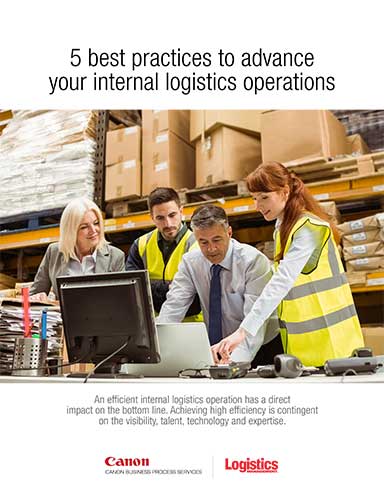Who’s using AIDC in the warehouse & DC?
VDC Research’s David Krebs provides an update on automatic identification and data capture solution adoption and how the hardware and software help companies achieve their warehouse and DC throughput goals in the tight labor market.
Warehouses and DCs continue to invest in technology that helps these critical hubs run more efficiently at a time when high demand, low labor availability, fast shipping expectations and other forces are creating new daily challenges. When hardware and software vendors come up with new ways to solve warehouse and DC pain points, many organizations are eager to test out, implement and begin using these innovations.
Because accurate data helps companies establish baselines, set benchmarks and achieve goals, collecting it has become a focal point for many warehouse operations that want to be able to do more with less.

As such, demand for the automatic identification and data capture (AIDC) solutions that identify, track, record, store and communicate essential data has continued in 2022 and is expected to remain steady as we move into 2023, according to analyst firm VDC Research, which tracks this space.
As the front end of enterprise software systems, AIDC technologies provide fast and accurate collection and entry of data. In the warehouse and DC, multiple AIDC technologies can be combined to create a single, enterprise-wide solution.
The solutions include—but aren’t limited to—bar codes, biometrics, RFID, machine vision, real-time locating systems, and voice and optical character recognition, according to AIM North America, an alliance enabling the cooperation, development, standardization of AIDC technologies.
Shaking off pandemic impacts
The toll the pandemic took on global supply chains is one of several AIDC market drivers right now. Coming into 2022, VDC Research was expecting an 8% increase in AIDC sales—nearly double historical averages—as a result of increased demand for logistics automation.
“As the Covid pandemic forced enterprises to adapt to new order fulfillment channels, technology investments have accelerated and VDC expects this to continue into 2022,” the company explained in its outlook report.
Looking back, the AIDC market grew 4% to 6% annually over the previous five years, with 2021 seeing a nearly 10% growth increase across all AIDC technologies for the year. VDC says that 12-month surge was driven by stronger demand for automation in logistics workflows to support both e-commerce and omni-channel fulfillment.
“Enterprises have looked toward bolstering automation solutions in order to streamline output productivity and optimize labor availability,” the company points out.
The persistent labor shortage is also playing a role in market growth. Not able to find the labor they need to operate facilities, more companies are turning to robotics and AI-enabled software solutions to boost productivity, optimize inventory, reduce waste, cut order lead times and achieve the “perfect order.” These are some of the reasons that demand for automation solutions remains robust and continues to drive interest in AIDC solutions, according to VDC.
Tracking new trends
Reflecting on what’s taken place so far in 2022, David Krebs, executive vice president of enterprise mobility and the connected worker at VDC, says the company’s projections for an active year in AIDC investment and usage were on target.
In many cases, companies whose supply chains came up short during the early stages of the pandemic have been some of the biggest AIDC adopters over the last two years.
“We’ve seen an acceleration in trends that were already developing,” Krebs says, “including the shortcomings of investments made to support supply chain operations over the last 24 months.” Admitting that many of the rapid, pandemic-driven changes in consumer demand and purchasing habits were hard to predict in advance, Krebs says that broadly speaking, supply chain operations were “ill equipped to manage the disruption.”
As a result, organizations have accelerated adoption of digital solutions in a race to gain greater operational agility and resilience. Much of that effort has been centered on labor and on optimizing frontline worker workflows. “We’ve seen a massive migration toward modern Android-powered devices that provide far greater functionality than many of the legacy mobile solutions,” says Krebs.
For example, one change VDC has been tracking is the shift away from investing in single-purpose mobile solutions in favor of options that comprehensively support the worker. Credit the ongoing labor shortage and increased focus on retaining capable workers with driving at least some of this shift. “During a time of labor shortage and rising labor costs,” Krebs points out, “employee training and engagement have been a priority.”
AIDC adoption rates and trends
Adoption of AIDC solutions is fairly ubiquitous across virtually every industry, despite the fact that the core solutions themselves haven’t “changed substantially” in recent years, Krebs says. “Consider that the UPC code on the infamous pack of gum scanned at the grocery store in Ohio several decades ago is the same UPC code still being scanned at the register,” he notes.
What we are seeing are organizations and industries taking a closer look at the data they need to run their businesses. This in turn is driving serialization efforts across multiple sectors, including more widespread adoption of 2D codes such as GS1 DataMatrix or QR codes that can encode variable data that uniquely identifies a product.
In addition, Krebs says the explosion of QR code scanning over the past 24 months is opening the door for consumer engagement opportunities for brand owners. “Mobile computing solutions continue to evolve with the recent shift to more powerful, ergonomic and modern Android-powered mobile solutions to innovation around the wearable form factor,” he says, “and the growing popularity of glove/hand-strap based solutions that enable hands-free operations.”
On the mobile side, there’s been greater focus on employee engagement, including the growing involvement of human resources in AIDC solution investment decisions. Krebs has also seen expanding opportunities for Tier II and III AIDC vendors to participate in deals they previously may not have had access to.
He credits the supply chain disruptions and product availability issues with creating these opportunities for smaller vendors. This also opens the door for companies investing in AIDC to work with innovative vendors that may not have previously been on those customers’ radar screens.
Improving efficiency and productivity
From a pure technology perspective, Krebs is also seeing greater adoption of vision and camera-based data capture solutions, including growing opportunities for UHF RFID (passive) in logistics environments.
He points to UPS’ intention to invest in RFID solutions that will streamline some of the more manual-intensive tasks (i.e., loading and unloading trucks) as one example of how organizations are focused on creating more agile operations.
The parcel carrier is implementing the initiative at 100 facilities this year and using RFID tags on packages to increase throughput at those locations.
“In the case of UPS, it claims to be able to eliminate up to 20 million manual scans per day through these investments,” Krebs says. The RFID tags will also help the company achieve its goal of eliminating $500 million in non-operating costs for 2022.
“It will eliminate all the manual scans done by our pre-loaders. If that doesn’t drive productivity, I don’t know what will,” UPS CEO Carol Tomé said on a recent earnings call. “It will avoid all the miss-sorts—when a package gets miss-sorted and goes into the wrong package car. That’s not a very good experience for our customer and is actually just a drag on productivity.”
When you infuse technology into the busy fulfillment and distribution environment, however, it can free up a lot of manual activities. That’s exactly what UPS says it wants to do, and why the carrier is putting resources where Tomé feels it will get the highest return on its investment.
“As it relates to the RFID technology, we were worried about putting it in this year because of supply chain jams. But we were able to procure all the batteries and labels that we [needed],” she said on the call. “So we will get it up this year before peak at 100 of our centers. What this will do long-term for us [looks] pretty powerful; wave one alone.”
Adapting to changing market conditions
Similar to most manufacturing sectors right now, fulfilling customer demand for products has and continues to be an issue for most of the AIDC hardware vendors.
Lead times can run as long as several months, Krebs says. Concurrently, the increased cost of already-scarce components plus increases in shipping/logistics costs are both driving up the price of the AIDC solutions.
“Some vendors are doing better than others, and especially those that have more vertically integrated manufacturing,” says Krebs. Despite these roadblocks, he sees the AIDC market continuing to grow as more organizations work toward their digital transformation goals. “AIDC solutions are fundamental to reaching those goals,” he says.
When investing in AIDC technologies for their operations, Krebs tells companies to look beyond the four walls of their operations and to avoid focusing solely on optimizing internal workflows as a means to improve supply chain operations. “To create the necessary agility and speed to counter current disruption,” he says, “investments in AI and machine learning solutions to create digital supply networks that interconnect trading partners will be critical.”
And given the persistent supply constraints, be sure to plan in advance. “With disruption to overall supply chain operations continuing,” Krebs adds, “make sure the solutions supporting your business provide the necessary agility to adapt to changing market conditions with greater resilience.”













